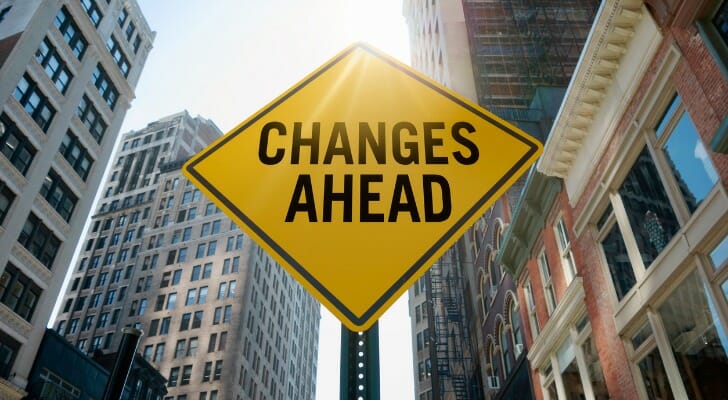The U.S. economy has moved into the late phase of the business cycle, according to Fidelity Investments, and that means investors should review their portfolio and its asset allocation and consider tactical adjustments. The late stage of the business cycle features volatile markets, slower economic growth, rising equity values and increasing signs of an eventual recession, the brokerage said. Here’s what you should do to position your portfolio for maximum gains and minimum losses. Consider working with a financial advisor as you contemplate portfolio changes in response to the late stage of the business cycle.
What Is the Business Cycle?
The business cycle is the fluctuation of macroeconomic trends, and it normally follows a pretty standard set of stages, measured by real gross domestic product (GDP) or GDP adjusted for inflation.
The business cycle begins with expansion, then it reaches a peak. After that economic activity begins to decline, and then the economy enters a recession. Once the economy is in recession conditions stabilize in what is sometimes called a trough. The last stage, before the next expansion, is known as the recovery.
The National Bureau of Economic Research (NBER) monitors the business cycle through quarterly GDP growth. Employment, personal income, manufacturing, and retail sales all help the NBER determine the stages of the business cycle.
What the Late Stage of the Business Cycle Looks Like
 Rather than a recession, the current late stage of the U.S. economy’s business cycle is marked by a tight labor market, declining profit margins, rising inventories, tighter monetary policy and a flatter yield curve, according to Fidelity. During the late stage, economic activity often reaches its peak, with slowing growth and declining corporate profits. Rising inflation and a tight labor market may prompt the Federal Reserve to raise interest rates. The late cycle ends when economic activity contracts and the economy enters recession, which is normally defined as two consecutive quarters of declining GDP.
Rather than a recession, the current late stage of the U.S. economy’s business cycle is marked by a tight labor market, declining profit margins, rising inventories, tighter monetary policy and a flatter yield curve, according to Fidelity. During the late stage, economic activity often reaches its peak, with slowing growth and declining corporate profits. Rising inflation and a tight labor market may prompt the Federal Reserve to raise interest rates. The late cycle ends when economic activity contracts and the economy enters recession, which is normally defined as two consecutive quarters of declining GDP.
“Nominal wage growth [as of mid-2022] is the highest in decades, but high inflation has rendered real wage growth negative and is weighing heavily on consumer confidence and real income expectations,” Dirk Hofschire, Fidelity’s senior vice president of asset allocation research, said. “Manufacturing supply-related pressures have started to ease, but housing and food inflation remain elevated, suggesting inflation will likely moderate but remain higher than in recent decades.”
U.S. stocks have risen an average of 6% annually in late stages of business cycles, says Fidelity.
How to ‘Play’ the Late Stage of the Business Cycle
Just as the expansion stage of the business cycle disproportionately benefits certain sectors, the late stage disproportionately benefits other sectors. Energy, materials and commodities, for example, have done well in the late stage of the business cycle. Also, shares of corporations that sell essential products and services, such as consumer staples, utilities and healthcare, tend to do well.
On the other hand, economically sensitive sectors, especially interest-rate sensitive stocks, like information technology, real estate and consumer discretionary stocks, tend to do poorly in the late stage.
As for fixed-income securities, “higher inflation and interest rates that are typical of the late cycle have weighed on the price performance of longer-duration bonds in the past, but those higher rates may also create opportunities for income-seeking bond investors,” Fidelity said. “Cash has historically tended to outperform bonds during the late cycle, and money markets and CDs have benefited from higher rates as well.”
The Bottom Line

The late stage of the business cycle, such as the U.S. economy has been in during much of 2022, is marked by market volatility, rising share prices and slowing growth. If history is a guide then a recession is right around the corner. Fidelity says stocks, bonds and cash have delivered similar returns during the late cycle. The late stage is the time to invest in consumer staples, commodities and materials, energy and healthcare, among other options. Finally, make sure you have a long-term asset allocation plan – and stick to it – rather than being whipsawed by market volatility.
Tips on Investing
- Analyzing securities during the late stage can be challenging, which is one reason a financial advisor can be so valuable. Finding a qualified financial advisor doesn’t have to be hard. SmartAsset’s free tool matches you with up to three financial advisors who serve your area, and you can interview your advisor matches at no cost to decide which one is right for you. If you’re ready to find an advisor who can help you achieve your financial goals, get started now.
- Use our free investment calculator to get a quick estimate of how your investments can be expected to do.
Photo credit: ©iStock.com/kate_sept2004, ©iStock.com/David Gyung, ©iStock.com/gerenme
